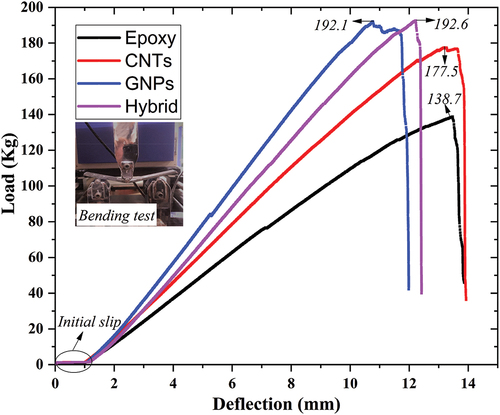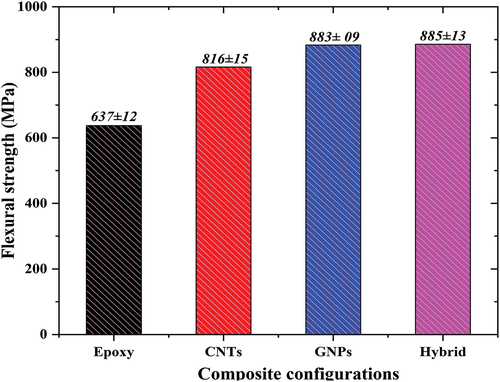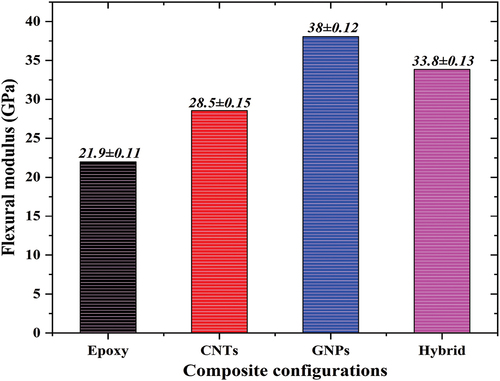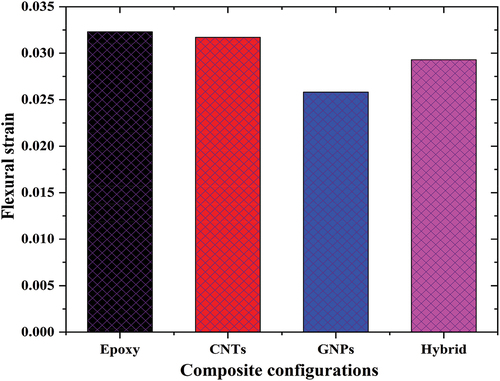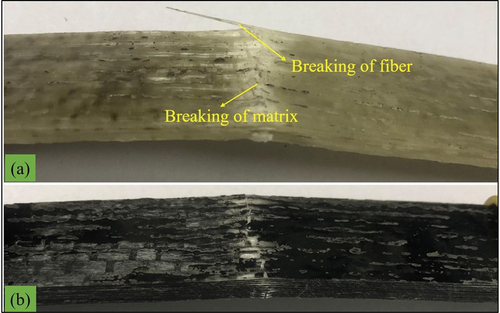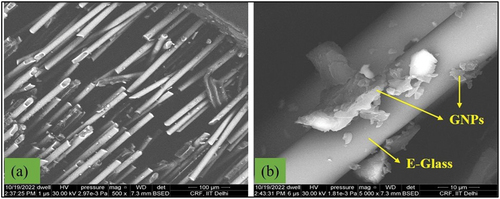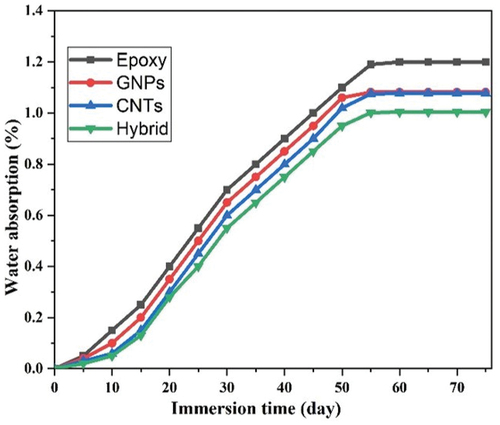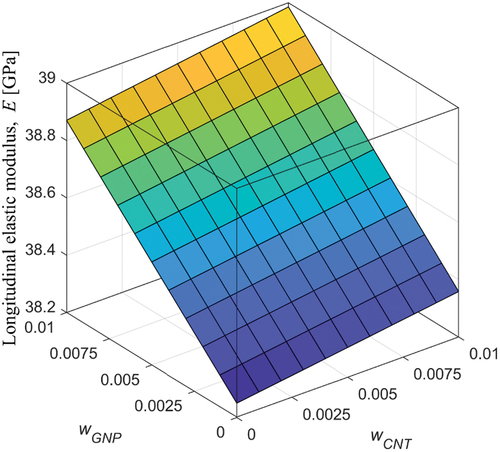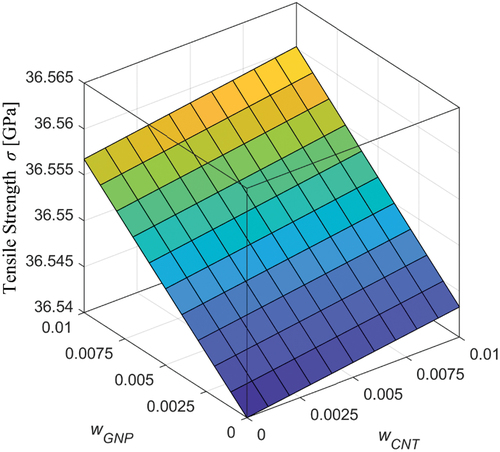 ?Mathematical formulae have been encoded as MathML and are displayed in this HTML version using MathJax in order to improve their display. Uncheck the box to turn MathJax off. This feature requires Javascript. Click on a formula to zoom.
?Mathematical formulae have been encoded as MathML and are displayed in this HTML version using MathJax in order to improve their display. Uncheck the box to turn MathJax off. This feature requires Javascript. Click on a formula to zoom.Abstract
The current study focuses on the investigation of the synergetic effect of graphene nanoplatelets (GNPs) and carbon nanotubes (CNTs) on the flexural properties, hardness and water absorption characteristics of glass fiber reinforced polymer (GFRP) laminated composite materials. The laminated composite materials were fabricated with various configuration of filler reinforcements using vacuum assisted hand lay-up technique. Further, micromechanical analysis was performed using Halpin-Tsai model to investigate the synergistic effect of CNT/GNP hybrid glass fiber reinforced epoxy nanocomposites. It was observed that the CNT and GNP reinforced hybrid composite exhibited highest value of flexural strength and hardness; the respective values being 38% and 29% higher in comparison to the neat epoxy composite. Furthermore, among GNP and CNT, the composite containing former reinforcement exhibited better mechanical properties. The composites containing nanoparticles also exhibited better water uptake characteristic, where the weight gain for hybrid composite was 1.004%, whereas, for neat epoxy composite, the weight gain was 1.210%. This was attributed to the ability of nanofillers to restrict the intermolecular movement of the surrounding GFRP composites, which delays the relaxation of polymer chains, thereby reducing the diffusion of tiny molecules through the composites. It was also observed that the addition of GNPs has a strong effect on the elastic properties of the hybrid glass fiber reinforced epoxy nanocomposite than the addition of CNTs.
1. Introduction
In recent days, nanocomposites are playing a significant role in many engineering applications such as aircraft, automotive and aerospace due to their fascinating properties such as light weight, high strength and load carrying capacity. In this vein, fillers such as graphene and carbon nanotubes (CNTs) are the latest and most widely used reinforcing nanomaterials. Graphene and CNTs are an allotropy of carbon with superior mechanical, thermal and electrical properties (Kassa & Arumugam, Citation2020; Kassa et al., Citation2020; Kebede Kassa & Babu Arumugam, Citation2022) Graphene has got many applications in diverse fields such as hydrogen storage (Verma & Parashar, Citation2017) water desalination (Verma, Jain, et al., Citation2022) etc. Graphene related materials have different family such as graphene oxide (GO), pristine graphene, reduced graphene oxide (rGO) and graphene nanoplatelets (GNPs). Among them, GNPs are much cheaper form of graphene and are commercially available (Verma & Parashar, Citation2018). Similarly, CNTs are rolled graphene sheets and has two types: single walled carbon nanotubes (SWCNTs) and multi-walled carbon nanotubes (MWCNTs), which is relatively low cost. In addition, CNTs and GNPs have prompted researchers to explore their marvelous capabilities for reinforcing various polymer composite materials especially epoxy based composite materials. In general, epoxy composite materials are obtained from epoxy resins (Verma et al., Citation2017; Verma, Joshi, et al., Citation2018) and several studies have been performed and reported regarding epoxy based composite materials. To mention a few (Verma & Singh, Citation2018), studied the microstructural, mechanical and thermal characteristics of epoxy based human hair (HH) reinforced composites. Their results demonstrated that cured epoxy-based composite containing 7 wt.% of HH fiber content was the best of all the combinations. Presented the factors affecting the impact strength of synthetic fiber-reinforced epoxy composites (Lila et al., Citation2022). Studied the mechanical strength and thermal stability of nonwoven waste cellulose fabric reinforced epoxy-based composite. Their results indicated that the composite yields a high toughness and can be used for coating applications (Rastogi et al., Citation2020). Studied the water absorption characteristics of biocomposites derived from a starch-glycerol biodegradable matrix reinforced with jute fibers. They demonstrated that the major drawback of bio-composite, which is poor water absorption characteristics can be inhibited by the epoxy resin layer (Verma, Joshi, et al., Citation2018). Moreover, characterized the thermal and physical properties of chicken feather fiber (CFF) and crumb rubber (CR)-filled epoxy hybrid composite with different weight percentage of CFF and CR. Their results showed that the properties of the hybrid composite improved significantly compared to the pure fiber reinforced composite (Verma, Negi, et al., Citation2018). Also, reported that the mechanical properties of carbon fiber reinforced epoxy resin composite laminates. It was noticed that CNTs/GNPs hybrids composites were improved the properties (P. N. Wang et al., Citation2015). In addition, researchers have introduced various fillers into fiber-reinforced polymer composites to improve their overall mechanical and structural properties. For instance, studied the influence of graphene nanoplatelets (GNPs) on the flexural properties of fiber metal laminates (FMLs) subjected to marine environment. The results indicated that the addition of GNPs increased the flexural strength and modulus of the nanocomposite. Presented a review of existing literatures to explore the latest trends in the development of advance FMLs reinforced with nanoparticles (Keshavarz et al., Citation2020). The review revealed that the significant impact of CNTs on various properties are being extensively studied. However, the review indicated that more research is needed to investigate the effects of nanoparticles such as graphene on the mechanical behavior of FMLs (Kamaraj et al., Citation2020). Investigated the flexural, tensile, water absorption and flammability behavior of flax laminated composites reinforced with various concentrations of GNPs. It was reported that the best results in tensile and flexural strength properties were obtained at 0.1 wt.% of GNP concentration (Kamaraj et al., Citation2020). In another study, the cryogenic interlaminar shear strength (ILSS) of graphene oxide (GO) reinforced GFRP (glass fibre reinforced polymer) composites was studied by (Shen et al., Citation2015). Their results indicated that the cryogenic ILSS of GFRP composite was improved by 32.1% with the addition of 0.3 wt % GO. It was also noticed that better results were obtained for cryogenic temperature as compared to room temperature. The mechanical properties of GO and reduced graphene oxide (rGO) reinforced GFRP laminated composites were investigated by (Mahmood et al., Citation2018). Their results demonstrated that the graphene oxide coated laminated composites displayed better mechanical properties in comparison to uncoated graphene oxide GFRP laminated composites. Furthermore, investigated the microwave absorption and mechanical properties GNP reinforced GFRP composites. It was noticed that the addition of 0.2 wt.% graphene led to an increase in the elastic modulus and flexural behavior of GFRP composite by 58.4% and 78.8%, respectively (Qing et al., Citation2016). Studied the thermal stability and mechanical properties of multifunctional sandwich nanocomposites. It was reported that the mechanical properties and thermal stability of multifunctional sandwich nanocomposites were improved by adding different concentration of GNPs (Civalek et al., Citation2020). Investigated the mechanical properties of CNT and graphene reinforced hybrid CFRP (Carbon-fiber-reinforced polymer) subjected to different temperature viz. 25 °C, 65 °C and 85 °C and moisture. Their results demonstrated that the mechanical properties of CFRP composites improved by incorporating the filler reinforcements (Chiang et al., Citation2020). Moreover, studied the mechanical and interfacial characteristics of graphene and CNT reinforced CFRP laminated composites. It was observed that the flexural and tensile strength improved by 52% and 70%, respectively by incorporating CNT/graphene fillers (Qin et al., Citation2020). Studied the influence of graphene nanoparticles on the dynamic and quasi-static behavior of unidirectional and woven laminated carbon fiber reinforced metal composites. It was observed that the addition of 0.5 wt.% of graphene enhanced the flexural modulus, flexural strength and fracture strain of the unidirectional carbon fiber reinforced composite by 61.3%, 60.3% and 34.5%, respectively and the respective properties increased by 48%, 23.1% and 19.3% for woven carbon fiber laminated composites (S. Wang et al., Citation2022). Characterized the fracture characteristics of MWCNTs and graphene reinforced carbon fiber based laminated composites. In addition, the influence of polyphenylene and epoxy matrix on the fracture toughness of the laminated composite was examined. The experimental measurement of the overall mechanical properties, thermal conductivity and fracture toughness of GNP or CNT based nanocomposites are complex, costly and time-consuming (Liu et al., Citation2019). Thus, atomistic based simulation techniques are the only viable alternatives for accurately predicting the mechanical properties of a nanocomposite (Verma, Parashar, et al., Citation2018). To mention a few, demonstrated that atomistic simulations are accurate enough to predict the mechanical, fracture and thermal properties of graphene and h-BN-reinforced nanocomposites (Verma, Parashar, et al., Citation2022). Further, analyzed the reinforcing capabilities of bi-crystalline graphene and pristine graphene nanosheet using simulation. Their result indicated that bi-crystalline graphene is a better reinforcing material for developing the future nanocomposites as compared to the pristine graphene (Verma et al., Citation2019). Apart from the above literatures, several groups have published an experimental and numerical study on the influence of CNTs on the mechanical and structural properties of GFRP laminated composites (Kassa et al., Citation2021a; Kassa et al., Citation2022; Kebede Kassa et al., Citation2020; Kishore et al., Citation2020a, Citation2020b, Eslami-Farsani et al., Citation2022). To the best of the authors’ knowledge, there has been very few study where the synergistic effect of CNT and GNP has been discussed. Therefore, the main aim of this research work is to study the synergetic effect of CNT and GNP on the flexural properties, hardness, water uptake elastic and strength characteristics of GFRP laminated composites.
2. Experimental procedure
2.1. Materials and fabrication of multiscale nanocomposite laminates
In this study, unidirectional E-glass fiber as used as the reinforcement material, CNT and GNP were used as fillers and LY-556 epoxy resin with hardener HY-951 was used as the matrix to prepare the multi-scale composite laminates. To investigate the influence of CNT and GNP on the mechanical properties of the nanocomposite, the following samples were prepared: glass fibre/epoxy composite (designated as Epoxy), 1 wt.% CNT/glass fibre/epoxy composite (designated as CNTs), 1 wt.% GNP/glass fibre/epoxy composite (designated as GNPs) and 0.5 wt.% CNT/0.5 wt.% GNP/glass fibre/epoxy composite (designated as Hybrid). The samples were fabricated from 10 layers of unidirectional glass fiber (total thickness of 4 mm) via vacuum assisted hand layup technique. The matrix: E-glass fiber weight ratio in the present study was 1:1. It is important to note that to improve the dispersion of nanoparticles in epoxy resin, the mixture was ultrasonicated for 1 h. After lamination, the specimens were kept in vacuum bag to remove excess resin and bubbles. Subsequently, the samples were kept at room temperature for curing. Finally, the specimens were cut to the required dimensions for the intended testing in accordance with ASTM standards.
2.2. Flexural test
In order to investigate the influence of CNT and GNP on the flexural behavior of laminated GFRP nanocomposites, a three-point bending test at room temperature was conducted according to ASTM D790 (ASTM D790, Citation1997) using a universal testing machine (INNOTECH UTM 9024) at a crosshead speed of 2 mm/min and a maximum load of 3000 kg. In general, three samples were tested for each condition and concentration of nanofillers. With reference to ASTM D790, flexural strength, flexural modulus and flexural strain can be obtained by using the following expressions:
where ,
and
denotes the flexural strength, flexural modulus and flexural strain, respectively; M, P, L, b, D and d denote the slope of the load-deflection curve, maximum load, length of support span, breadth, maximum deflection and depth of the specimen.
2.3. Void content
In the current study, void contents in the nanocomposites were measured in accordance with ASTM D2734–94 (ASTM D2734–94, Citation1994). EquationEquation (4)(4)
(4) is used to calculate the theoretical density (
).
where ,
and
denote the weight of the glass fiber, polymer matrix, CNTs and GNPs, respectively;
,
,
and
denote the density of fiber, matrix, CNT and GNP, respectively. Void content in the fabricated samples was estimated by utilizing the following equation:
where Vv is the void content (%) and denote the experimental density.
2.4. Vickers hardness
Vickers hardness testing was performed using a Vickers hardness machine (Rockwell Testing Aids). The nanocomposite samples were prepared in accordance with ASTM D-2240 (ASTM D2240–15, Citation2021). The indenter was of 1/16-inch diameter and a maximum load of 50 kg. The hardness values were taken 15 s after the diamond indenter came in close contact with the surface of the fabricated nanocomposite samples. For each configuration of the nanocomposite sample, a load of 490.5 N was applied to the upper surface of the nanocomposite specimens and the hardness value was measured over 10 traces. The hardness value was calculated with the help of the following equation:
where HV, F and D are the hardness value, load and diameter of the indenter, respectively.
2.5. Water absorption test
Water absorption mainly depends on the individual characteristics of composite constituents and the porosities present in the composite. The glass fibre is relatively more resistant to moisture than the other composite constituents. Polymer composite materials are widely used in most applications where exposure to a moist environment leads to a deterioration in the mechanical properties. Therefore, it becomes imperative to study the water absorption characteristics of the prepared composite samples. The water absorption test was carried out in accordance with ASTM D570 (ASTM D570–98, Citation2018). To investigate the influence of the environmental conditions on the mechanical properties of the nanocomposite samples, the fabricated specimens were immersed in to distil water for 75 days at room temperature. The specimens were then taken out from the distil water and cleaned with dry cloth. Subsequently, the weight of the specimens was measured and the water uptake of the specimens was computed using EquationEquation (7)(7)
(7) , and the average measured value for each condition was recorded.
where W is the percentage of water absorption; Wt and Wi are the weight of the sample after immersion and before immersion in the water, respectively.
2.6. Microstructural analysis
The microstructure of the samples was studied with the help of scanning electron microscope (SEM).
2.7. Micromechanical analysis
In the current study, the well-known and widely utilized Halpin-Tsai model has been employed to calculate the theoretical mechanical and strength properties of randomly distributed nanofiller reinforced nanocomposites. The details of the Halpin-Tsai mathematical equation, considering random orientation of the CNTs and GNPs can be written as follows:
The elastic modulus of the nanocomposites obtained as presented (Jen et al., Citation2020):
In this model, the parameters ,
,
and
can be expressed as presented below:
The volume fraction of CNTs and GNPs can be expressed as follows:
In the above relations, and
represent the average length and outer diameter of CNT, respectively;
and
denote the average of diameter and thickness of GNP, respectively;
and
are the aspect ratio of CNTs and GNPs, respectively;
and
are the volume fraction of CNTs and GNPs;
,
are the weight fraction of CNT and GNP;
,
and
are the density of CNT, GNP and epoxy;
,
and
are the Young’s modulus of CNT, GNP and epoxy, respectively.
The tensile strength of nanocomposite, obtained as presented below (Navidfar & Trabzon, Citation2019):
The parameters,
,
and
can be defined as presented below:
In the above relations, C is the constant shape factor related to the aspect ratio of nanofillers; and
are the aspect ratio of GNP and CNT, respectively; the parameters
and
used for the CNT, while
and
used for GNP nanocomposites, respectively;
,
and
are the tensile strength of CNT, GNP and polymer matrix, respectively;
=(2
) and
=(2/3
).
After obtaining the elastic and strength properties of CNT and GNP reinforced polymer nanocomposite, the elastic and strength properties of glass fiber reinforced epoxy nanocomposite were calculated using the rule of mixture (ROM) as presented in the following (Kassa et al., Citation2021b):
where and
denotes the tensile strength and elastic modulus of GNP/CNT reinforced glass fiber polymer composite, respectively;
and
denoted as the volume fraction of glass fiber and CNT/GNP reinforced epoxy nanocomposites, respectively.
3. Results and discussion
3.1. Mechanical property
In order to investigate the influence of CNT and GNP on the flexural properties of GFRP composite, the flexural test was performed and the obtained results are presented in Figures .
The load applied as a function of deflection for various nanocomposite configurations was obtained from three-point bending test, as depicted in Figure . It can be seen that for all nanocomposite configurations, the deflection increases as the applied load increases until the test sample is unable to withstand further loading. It can also be seen that the maximum load that the nanocomposite can withstand increases of in order of Epoxy, CNTs, GNPs and Hybrid samples. This shows that the hybrid composite has a higher load carrying capacity as compared to the other nanocomposite configurations. This may be due to the higher fiber matrix interfacial strength contributed by both the filler reinforcements, CNT and GNP.
The variation in the flexural strength for various samples is shown in Figure . It can be observed that the flexural strength increases with the addition of nanoparticles. This may be attributed to the fact that the presence of nanoparticles in the layers of glass fiber and epoxy acts as arrester for slippage, thereby, preventing crack propagation (Zeng et al., Citation2017). Further, upon application of load, the stress can be transferred from epoxy to the reinforced nanoparticles. The hybrid GFRP nanocomposite displayed highest flexural strength; 38% higher than the neat epoxy composite. On the contrary, GNP reinforced composite exhibited highest value of flexural modulus (Figure ). This is due to the fact that the GNP possesses significantly higher elastic modulus in comparison to the CNT. Figure displays the value of strain at peak for the fabricated specimens. Considering the values of the aforementioned entities, i.e., flexural strength, flexural modulus and strain at peak, it can be inferred that the CNT and GNP reinforced hybrid composites are most suitable for various applications. Additionally, Vickers hardness test was performed to assess the properties at micro-level, whose results are shown in Table . In line with flexural strength, the hybrid composite exhibited the highest value of hardness followed by GNP reinforced composite, CNT reinforced composite and neat epoxy composite. GNP, by virtue of its large surface area, provides large contact area to the matrix. Both the surfaces of the GNPs interact with the matrix, as compared to only the outer surfaces of the CNTs (Singh et al., Citation2019). Also, as compared to MWCNTs, GNP possesses rougher nanoscale surface that enables stronger fiber/matrix interface interlocking (Zhang et al., Citation2010).
Table 1. Details of hardness, density and voids present in the studied specimens
For better understanding of the fracture behavior, the photographs of the failed sample are shown in Figure . It can be clearly seen that there is a significant delamination in the neat epoxy composite sample as compared to the hybrid composite sample. Breaking of fiber and clear separation of matrix is evident in neat epoxy composite. The SEM images of the fractured surface of CNT/GNP reinforced hybrid composite are illustrated in Figure . Fiber breaking phenomenon can be clearly seen in Figure and the presence of GNPs over the glass fiber is evident in Figure , which indicates the existence of reasonably good adhesion between the fiber and reinforcement.
3.2. Void content and density
It is well known that trapped air volatilities exist in the composite during the impregnation of the matrix in the fiber during the fabrication of the composite using hand layup technique. During the fabrication and curing process, resin flow through the fiber layer influences the void content, which could affect the mechanical and physical characteristics (Mallick, Citation2007). A decrease in the mechanical and physical properties of composites is expected due to the presence of voids. Therefore, it is important to study the void content of the fabricated composite specimens. The values of theoretical density, measured density and voids present in the fabricated specimens are shown in Table . Among the investigated composite specimens, neat epoxy showed the highest void percentage, whereas, the samples containing nanoparticles exhibited relatively low void content. Though it has been reported that the geometry and morphology of the filler material play a substantial role in determining the void content, in this case, the nanoparticle containing samples had similar void content. This may be attributed to relatively uniform dispersion of nanoparticles since agglomeration leads to the formation of voids in the sample.
3.3. Water uptake capacity
The water uptake capacity of the composite samples for various reinforcing fillers has been illustrated in Figure and Table . As can be inferred from Figure that irrespective of the composite configuration, the samples followed similar trend. The water uptake initially increases drastically following which it reaches a saturation state and the uptake becomes almost constant. The higher water absorption value at the initial stage of immersion is attributed to the remained bubbles and defects present in the composite samples, but as the immersion time increases, a saturation phenomenon occurs. The average water uptake capacity of the composite samples is presented in Table . It can be seen from the table that the sample of neat epoxy resin glass fiber reinforced composite has the highest water uptake, while the CNT and GNP reinforced hybrid composites have the lowest water uptake value. It can also be observed that the water absorption of the tested samples decreases in order of neat epoxy, GNPs, CNTs and hybrid samples. This shows that the nanofillers act as an effective water barrier that reduces water absorption in GFRP composites. This is associated with the ability of nanofillers to restrict the intermolecular movement of the surrounding GFRP composites, which delays the relaxation of polymer chains, thereby reducing the diffusion of tiny molecules through the composites. However, it must be remembered that the water uptake capacity of GFRP composites differs depending on the type of nanofiller reinforcement.
Table 2. Weight gain post water absorption test for the fabricated samples
3.4. Numerical results
3.4.1. Validation study
To verify the effectiveness of the micromechanical model, a validation study was conducted by comparing the numerical results with the experimental results, which are presented in Table . The weight fraction of CNTs and GNPs is assumed to be 1%. It can be observed from Table that there is a good agreement between experimental and analytical Halpin-Tsai model results.
Table 3. Comparison of the elastic modulus of hybrid CNTs/GNPs reinforced glass fiber epoxy nanocomposite using Halpin-Tsai model and experimental measurements
3.4.2. Parametric study
In the following subsections, the influence of the weight fraction of CNTs and GNPs on the strength and elastic properties of glass fiber reinforced epoxy nanocomposite was investigated and presented for better understanding of the synergistic effect of CNTs and GNPs. For parametric analysis, the following material and strength properties of the individual constituents are used in Halpin-Tsai model (Table ).
Table 4. Material and strength properties of individual constituents (Kilikevičius et al., Citation2021; Rouway et al., Citation2021)
3.4.2.1. Effect of weight fraction CNTs and GNPs on the elastic properties of glass fiber reinforced epoxy nanocomposite
The influence of weight fraction of CNTs and GNPs on the elastic properties of glass fiber reinforced epoxy nanocomposite was investigated, and the results are presented in Figure . The aspect ratio of CNTs and GNPs is assumed to be 50, and the weight fraction for CNTs and GNPs ranged from 0% to 1.5%. It can be observed from Figure that as both the weight fraction of CNTs and GNPs increases the elastic modulus also increases. It can also be observed that addition of GNPs has a strong effect on the elastic properties of the hybrid glass fiber reinforced epoxy nanocomposite than the addition of CNTs. In summary, it can be concluded that the weight fraction proportion of CNTs and GNPs has a significant effect on the elastic properties of glass fiber reinforced epoxy nanocomposite.
3.4.2.2. Effect of aspect ratio of CNTs and GNPs on the elastic properties of glass fiber/epoxy laminated composite
The influence of aspect ratio of CNTs and GNPs on the elastic properties of glass fiber reinforced epoxy nanocomposite was investigated, and the results are presented in Figure . The weight fraction of CNTs and GNPs is assumed to be 1%, and the aspect ratio for CNTs and GNPs ranged from 50 to 100. As expected, the elastic modulus increases as the aspect ratio increases irrespective of the filler material. It can also be observed that the elastic modulus significantly improved when the aspect ratio of the filler was equal.
3.4.2.3. Effect of weight fraction of CNTs and GNPs on the strength properties of glass fiber/epoxy laminated composite
The influence of weight fraction of CNTs and GNPs on the tensile strength of glass fiber reinforced epoxy nanocomposite was investigated, and the results are presented in Figure . The aspect ratio of CNTs and GNPs is assumed to be 50, and the weight fraction for CNTs and GNPs ranged from 0% to 1.5%. As expected, it can be noticed from the tensile strength of the glass fiber reinforced epoxy nanocomposite increases as the weight fraction of CNTs and GNPs increases, which is a similar observation for the elastic modulus. In conclusion, the synergistic effect of CNT/GNP hybrid composite on tensile strength is higher than that of individual filler.
4. Conclusion
In this research work, the synergetic effect of CNT and GNP nanofillers on the flexural properties, hardness, water uptake, elastic and strength characteristics of GFRP composites was investigated and presented. The GFRP composite samples with different nanofiller configurations were fabricated using vacuum assisted hand layup method. Further, micromechanical analysis was performed using Halpin-Tsai model to investigate the synergistic effect of CNT/GNP hybrid glass fiber reinforced epoxy nanocomposites. The main conclusions of the study are drawn and presented as follows:
The addition of nanoparticles led to enhancement in the mechanical properties of the composites. Among GNP and CNT, the composite containing former reinforcement exhibited better mechanical properties. However, the CNT and GNP reinforced hybrid GFRP composites displayed highest value of flexural strength and hardness; the respective values being 38% and 29% higher in comparison to the neat epoxy composite.
The composites containing nanoparticles also exhibited better water uptake characteristic, where the weight gain for hybrid composite was 1.004%, whereas, for neat epoxy composite, the weight gain was 1.210%. This was attributed to the ability of nanofillers to restrict the intermolecular movement of the surrounding GFRP composites, which delays the relaxation of polymer chains, thereby reducing the diffusion of tiny molecules through the composites.
The neat epoxy composite sample had maximum voids, 6.519%. Also, there were not much variation in void content for nanoparticle reinforced composites. This may be attributed to relatively uniform dispersion of nanoparticles since agglomeration leads to the formation of voids in the sample.
The addition of GNPs has a strong effect on the elastic properties of the hybrid glass fiber reinforced epoxy nanocomposite than the addition of CNTs.
The weight fraction has a significant effect than the aspect ratio of CNTs and GNPs.
Data available statement
The authors confirm that the data supporting the findings of this study are available within the article.
Disclosure statement
No potential conflict of interest was reported by the author(s).
References
- ASTM D2240-15. (2021). Standard test method for rubber property—Durometer hardness. https://doi.org/10.1520/D2240-15R21.
- ASTM D2734-94. (1994). Standard test methods for void content of reinforced plastics.
- ASTM D570-98. (2018). Standard test method for water absorption of plastics. https://doi.org/10.1520/D0570-98R18.
- ASTM D790. (1997). Standard test methods for flexural properties of unreinforced and reinforced plastics and electrical insulating materials.
- Chiang, C. L., Chou, H. Y., & Shen, M. Y. (2020). Effect of environmental aging on mechanical properties of graphene nanoplatelet/nanocarbon aerogel hybrid-reinforced epoxy/carbon fiber composite laminates. Composites Part A, Applied Science and Manufacturing, 130, 105718. https://doi.org/10.1016/j.compositesa.2019.105718
- Civalek, Ö., Dastjerdi, S., & Akgöz, B. (2020). Buckling and free vibrations of CNT-reinforced cross-ply laminated composite plates. Mechanics Based Design of Structures and Machines, 50(6), 1914–16. https://doi.org/10.1080/15397734.2020.1766494
- Eslami-Farsani, R., Aghamohammadi, H., Khalili, S. M. R., Ebrahimnezhad Khaljiri, H., & Jalali, H. (2022). Recent trend in developing advanced fiber metal laminates reinforced with nanoparticles: A review study. Journal of Industrial Textiles, 51(5_suppl), 7374S–7408S. https://doi.org/10.1177/1528083720947106
- Jen, Y. M., Huang, J. C., & Zheng, K. Y. (2020). Synergistic effect of multi-walled carbon nanotubes and graphene nanoplatelets on the monotonic and fatigue properties of uncracked and cracked epoxy composites. Polymers (Basel), 12(9), 1895. https://doi.org/10.3390/POLYM12091895
- Kamaraj, M., Dodson, E. A., & Datta, S. (2020). Effect of graphene on the properties of flax fabric reinforced epoxy composites. Advanced Composite Materials, 29(5), 443–458. https://doi.org/10.1080/09243046.2019.1709679
- Kassa, M. K., & Arumugam, A. B. (2020). Micromechanical modeling and characterization of elastic behavior of carbon nanotube‐reinforced polymer nanocomposites: A combined numerical approach and experimental verification. Polymer Composites, 41(8), 3322–3339. https://doi.org/10.1002/pc.25622
- Kassa, M. K., Arumugam, A. B., & Rana, T. (2020). Three-phase modelling and characterization of elastic behavior of MWCNT reinforced GFRP composites: A combined numerical and experimental study. Materials Today: Proceedings, 26, 944–949. https://doi.org/10.1016/j.matpr.2020.01.152
- Kassa, M. K., Selvaraj, R., Wube, H. D., & Arumugam, A. B. (2021a). Investigation of the bending response of carbon nanotubes reinforced laminated tapered spherical composite panels with the influence of waviness, interphase and agglomeration. Mechanics Based Design of Structures and Machines, 1–23. https://doi.org/10.1080/15397734.2021.2017966/
- Kassa, M. K., Selvaraj, R., Wube, H. D., & Arumugam, A. B. (2021b). Investigation of the bending response of carbon nanotubes reinforced laminated tapered spherical composite panels with the influence of waviness, interphase and agglomeration. Mechanics Based Design of Structures and Machines, 1–23. https://doi.org/10.1080/15397734.2021.2017966
- Kassa, M. K., Singh, L. K., & Arumugam, A. B. (2022). Numerical and experimental investigation of first ply failure response of multi-walled carbon nanotubes/epoxy/glass fiber hybrid laminated tapered curved composite panels. Proceedings of the Institution of Mechanical Engineers, Part C: Journal of Mechanical Engineering Science, 236(15), 8481–8496. https://doi.org/10.1177/09544062221085896
- Kebede Kassa, M., Arumugam, A. B., and Singh, B. (2020). Prediction of thermo-mechanical properties of MWCNT-Reinforced GFRP and its thermo-elastic response analysis in laminated composite plate. In Proceedings of International Conference in Mechanical and Energy Technology, (pp. 285–296).
- Kebede Kassa, M., & Babu Arumugam, A. (2022, February). Bending response analysis of a laminated, tapered, curved, composite panel made from an agglomerated and wavy MWCNT–glass fiber–polymer hybrid. Transactions of the Canadian Society for Mechanical Engineering, 46(1), 103–131. https://doi.org/10.1139/tcsme-2021-0084
- Keshavarz, R., Aghamohammadi, H., & Eslami-Farsani, R. (2020). The effect of graphene nanoplatelets on the flexural properties of fiber metal laminates under marine environmental conditions. International Journal of Adhesion and Adhesives, 103, 102709. https://doi.org/10.1016/j.ijadhadh.2020.102709
- Kilikevičius, S., Kvietkaitė, S., Mishnaevsky, L., Omastová, M., Aniskevich, A., & Zeleniakienė, D. (2021, April). Novel hybrid polymer composites with graphene and mxene nano-reinforcements: Computational analysis. Polymers (Basel), 13(7), 1013. https://doi.org/10.3390/polym13071013
- Kishore, M., Amrita, M., and Kamesh, B. (2020a). Experimental investigation of milling on basalt-jute hybrid composites with graphene as nanofiller. In Materials today: Proceedings, 43, 726–730. https://doi.org/10.1016/j.matpr.2020.12.847.
- Kishore, M., Amrita, M., and Kamesh, B. (2020b). Tribological properties of basalt-jute hybrid composite with graphene as nanofiller. In Materials today: Proceedings, (Vol 43, pp. 244–249). https://doi.org/10.1016/j.matpr.2020.11.654.
- Lila, M. K., Verma, A., & Bhurat, S. S. (2022). Impact behaviors of epoxy/synthetic fiber composites. In Handbook of epoxy/fiber composites (pp. 1–18). Springer Singapore. https://doi.org/10.1007/978-981-15-8141-0_55-1
- Liu, J., Fu, J., Ni, T., & Yang, Y. (2019). Fracture toughness improvement of multi-wall carbon nanotubes/graphene sheets reinforced cement paste. Construction and Building Materials, 200, 530–538. https://doi.org/10.1016/j.conbuildmat.2018.12.141
- Mahmood, H., Vanzetti, L., Bersani, M., & Pegoretti, A. (2018). Mechanical properties and strain monitoring of glass-epoxy composites with graphene-coated fibers. Composites Part A, Applied Science and Manufacturing, 107, 112–123. https://doi.org/10.1016/j.compositesa.2017.12.023
- Mallick, P. K. (2007). Fiber-reinforced composites: materials, manufacturing, and design. CRC press.
- Navidfar, A., & Trabzon, L. (2019). Graphene type dependence of carbon nanotubes/graphene nanoplatelets polyurethane hybrid nanocomposites: Micromechanical modeling and mechanical properties. Composites Part B: Engineering, 176(July), 107337. https://doi.org/10.1016/j.compositesb.2019.107337
- Qin, W., Chen, C., Zhou, J., & Meng, J. (2020). Synergistic effects of graphene/carbon nanotubes hybrid coating on the interfacial and mechanical properties of fiber composites. Materials (Basel), 13(6), 1457. https://doi.org/10.3390/ma13061457
- Qing, Y., Jie, W., Wang, H., Fa, L., & Zhou, W. (2016). Graphene nanosheets/E-glass/epoxy composites with enhanced mechanical and electromagnetic performance. RSC Advances, 6(84), 80424–80430. https://doi.org/10.1039/c6ra15116g
- Rastogi, S., Verma, A., & Singh, V. K. (2020). Experimental response of nonwoven waste cellulose fabric–reinforced epoxy composites for high toughness and coating applications. Materials Performance and Characterization, 9(1), 151–172. https://doi.org/10.1520/MPC20190251
- Rouway, M., Nachtane, M., Tarfaoui, M., Chakhchaoui, N., Omari, L. E. H., Fraija, F., & Cherkaoui, O. (2021). Mechanical properties of a biocomposite based on carbon nanotube and graphene nanoplatelet reinforced polymers: Analytical and numerical study. Journal of Composites Science, 5(9), 234. https://doi.org/10.3390/JCS5090234
- Shen, X. J., Meng, L.-X., Yan, Z.-Y., Sun, C.-J., Ji, Y.-H., Xiao, H.-M., & Fu, S.-Y. (2015). Improved cryogenic interlaminar shear strength of glass fabric/epoxy composites by graphene oxide. Composites Part B: Engineering, 73, 126–131. https://doi.org/10.1016/j.compositesb.2014.12.023
- Singh, L. K., Bhadauria, A., & Laha, T. (2019). Comparing the strengthening efficiency of multiwalled carbon nanotubes and graphene nanoplatelets in aluminum matrix. Powder Technology, 356, 1059–1076. https://doi.org/10.1016/j.powtec.2019.09.026
- Verma, A., Gaur, A., & Singh, V. K. (2017). Mechanical properties and microstructure of starch and sisal fiber biocomposite modified with epoxy resin. Materials Performance and Characterization, 6(1), 20170069–20170520. https://doi.org/10.1520/MPC20170069
- Verma, A., Jain, N., & Sethi, S. K. (2022). Modeling and simulation of graphene-based composites. In Innovations in graphene-based polymer composites (pp. 167–198). Elsevier.
- Verma, A., Joshi, K., Gaur, A., & Singh, V. K. (2018). Starch-jute fiber hybrid biocomposite modified with an epoxy resin coating: Fabrication and experimental characterization. Journal of the Mechanical Behavior of Materials, 27(5–6). https://doi.org/10.1515/jmbm-2018-2006
- Verma, A., Negi, P., & Singh, V. K. (2018). Physical and thermal characterization of chicken feather fiber and crumb rubber reformed epoxy resin hybrid composite. Advances in Civil Engineering Materials, 7(1), 20180027–20180557. https://doi.org/10.1520/ACEM20180027
- Verma, A., & Parashar, A. (2017). The effect of STW defects on the mechanical properties and fracture toughness of pristine and hydrogenated graphene. Physical Chemistry Chemical Physics: PCCP, 19(24), 16023–16037. https://doi.org/10.1039/C7CP02366A
- Verma, A., & Parashar, A. (2018). Structural and chemical insights into thermal transport for strained functionalised graphene: A molecular dynamics study. Materials Research Express, 5(11), 115605. https://doi.org/10.1088/2053-1591/aade36
- Verma, A., Parashar, A., & Packirisamy, M. (2018). Atomistic modeling of graphene/hexagonal boron nitride polymer nanocomposites: A review. WIREs Computational Molecular Science, 8(3), e1346. https://doi.org/10.1002/wcms.1346
- Verma, A., Parashar, A., & Packirisamy, M. (2019). Effect of grain boundaries on the interfacial behaviour of graphene-polyethylene nanocomposite. Applied Surface Science, 470, 1085–1092. https://doi.org/10.1016/j.apsusc.2018.11.218
- Verma, A., Parashar, A., & van Duin, A. C. T. (2022). Graphene-reinforced polymeric membranes for water desalination and gas separation/barrier applications. In Innovations in graphene-based polymer composites (pp. 133–165). Elsevier. https://doi.org/10.1016/B978-0-12-823789-2.00009-1
- Verma, A., & Singh, V. K. (2018). Mechanical, microstructural and thermal characterization of epoxy-based human hair–reinforced composites. Journal of Testing and Evaluation, 47(2), 1193–1215. https://doi.org/10.1520/JTE20170063
- Wang, S., Cao, M., Xue, H., Araby, S., Abbassi, F., He, Y., Su, W., & Meng, Q. (2022). Investigation on graphene addition on the quasi-static and dynamic responses of carbon fibre-reinforced metal laminates. Thin-Walled Structures, 174(May), 21–23. https://doi.org/10.1016/j.tws.2022.109092
- Wang, P. N., Hsieh, T. H., Chiang, C. L., & Shen, M. Y. (2015). Synergetic effects of mechanical properties on graphene nanoplatelet and multiwalled carbon nanotube hybrids reinforced epoxy/carbon fiber composites. Journal of Nanomaterials, 2015, 1–9. https://doi.org/10.1155/2015/838032
- Zeng, S. H., Shen, M. X., Duan, P. P., Zheng, H. K., & Wang, Z. Y. (2017). Structure and property of carbon nanotubes attached glass fabric reinforced epoxy composites. Cailiao Gongcheng/Journal Materials Engineering, 45(9), 38–44. https://doi.org/10.11868/j.issn.1001-4381.2015.001326
- Zhang, J., Zhuang, R., Liu, J., Mäder, E., Heinrich, G., & Gao, S. (2010). Functional interphases with multi-walled carbon nanotubes in glass fibre/epoxy composites. Carbon NY, 48(8), 2273–2281. https://doi.org/10.1016/j.carbon.2010.03.001

